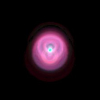Free Online Productivity Tools
i2Speak
i2Symbol
i2OCR
iTex2Img
iWeb2Print
iWeb2Shot
i2Type
iPdf2Split
iPdf2Merge
i2Bopomofo
i2Arabic
i2Style
i2Image
i2PDF
iLatex2Rtf
Sci2ools
VIS
2004
IEEE
2004
IEEE
Constrained Inverse Volume Rendering for Planetary Nebulae
Determining the three-dimensional structure of distant astronomical objects is a challenging task, given that terrestrial observations provide only one viewpoint. For this task, bipolar planetary nebulae are interesting objects of study because of their pronounced axial symmetry due to fundamental physical processes. Making use of this symmetry constraint, we present a technique to automatically recover the axisymmetric structure of bipolar planetary nebulae from two-dimensional images. With GPU-based volume rendering driving a non-linear optimization, we estimate the nebula's local emission density as a function of its radial and axial coordinates, and we recover the orientation of the nebula relative to Earth. The optimization refines the nebula model and its orientation by minimizing the differences between the rendered image and the original astronomical image. The resulting model enables realistic 3D visualizations of planetary nebulae, e.g. for educational purposes in plane...
Bipolar Planetary Nebulae | Inverse Volume Rendering | Pronounced Axial Symmetry | VIS 2004 | Visualization |
| Added | 05 Nov 2009 |
| Updated | 05 Nov 2009 |
| Type | Conference |
| Year | 2004 |
| Where | VIS |
| Authors | Charles D. Hansen, Gordon L. Kindlmann, Marcus A. Magnor |
Comments (0)

